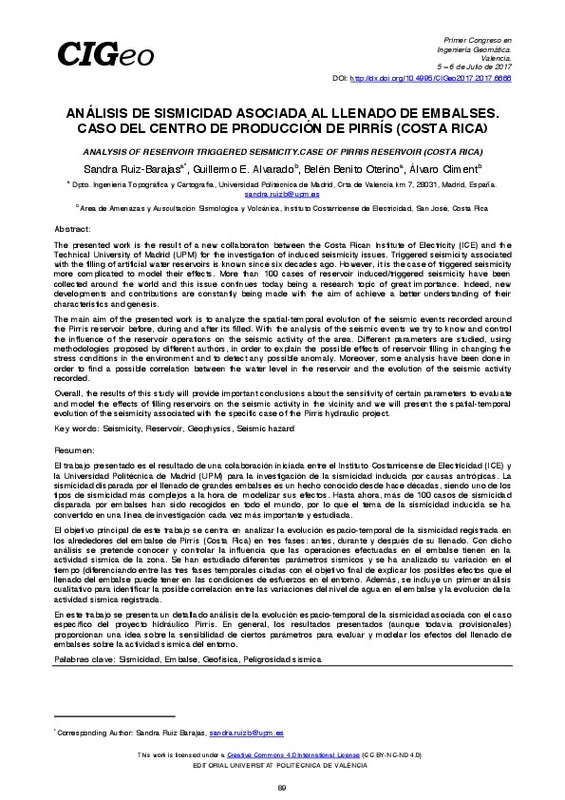|
[EN] The presented work is the result of a new collaboration between the Costa Rican Institute of Electricity (ICE) and the
Technical University of Madrid (UPM) for the investigation of induced seismicity issues. Triggered ...[+]
[EN] The presented work is the result of a new collaboration between the Costa Rican Institute of Electricity (ICE) and the
Technical University of Madrid (UPM) for the investigation of induced seismicity issues. Triggered seismicity associated
with the filling of artificial water reservoirs is known since six decades ago. However, it is the case of triggered seismicity
more complicated to model their effects. More than 100 cases of reservoir induced/triggered seismicity have been
collected around the world and this issue continues today being a research topic of great importance. Indeed, new
developments and contributions are constantly being made with the aim of achieve a better understanding of their
characteristics and genesis.
The main aim of the presented work is to analyze the spatial-temporal evolution of the seismic events recorded around
the Pirrís reservoir before, during and after its filled. With the analysis of the seismic events we try to know and control
the influence of the reservoir operations on the seismic activity of the area. Different parameters are studied, using
methodologies proposed by different authors, in order to explain the possible effects of reservoir filling in changing the
stress conditions in the environment and to detect any possible anomaly. Moreover, some analysis have been done in
order to find a possible correlation between the water level in the reservoir and the evolution of the seismic activity
recorded.
Overall, the results of this study will provide important conclusions about the sensitivity of certain parameters to evaluate
and model the effects of filling reservoirs on the seismic activity in the vicinity and we will present the spatial-temporal
evolution of the seismicity associated with the specific case of the Pirrís hydraulic project.
[-]
[ES] El trabajo presentado es el resultado de una colaboración iniciada entre el Instituto Costarricense de Electricidad (ICE) y
la Universidad Politécnica de Madrid (UPM) para la investigación de la sismicidad inducida ...[+]
[ES] El trabajo presentado es el resultado de una colaboración iniciada entre el Instituto Costarricense de Electricidad (ICE) y
la Universidad Politécnica de Madrid (UPM) para la investigación de la sismicidad inducida por causas antrópicas. La
sismicidad disparada por el llenado de grandes embalses es un hecho conocido desde hace décadas, siendo uno de los
tipos de sismicidad más complejos a la hora de modelizar sus efectos. Hasta ahora, más de 100 casos de sismicidad
disparada por embalses han sido recogidos en todo el mundo, por lo que el tema de la sismicidad inducida se ha
convertido en una línea de investigación cada vez más importante y estudiada.
El objetivo principal de este trabajo se centra en analizar la evolución espacio-temporal de la sismicidad registrada en
los alrededores del embalse de Pirrís (Costa Rica) en tres fases: antes, durante y después de su llenado. Con dicho
análisis se pretende conocer y controlar la influencia que las operaciones efectuadas en el embalse tienen en la
actividad sísmica de la zona. Se han estudiado diferentes parámetros sísmicos y se ha analizado su variación en el
tiempo (diferenciando entre las tres fases temporales citadas con el objetivo final de explicar los posibles efectos que el
llenado del embalse puede tener en las condiciones de esfuerzos en el entorno. Además, se incluye un primer análisis
cualitativo para identificar la posible correlación entre las variaciones del nivel de agua en el embalse y la evolución de la
actividad sísmica registrada.
En este trabajo se presenta un detallado análisis de la evolución espacio-temporal de la sismicidad asociada con el caso
específico del proyecto hidráulico Pirrís. En general, los resultados presentados (aunque todavía provisionales)
proporcionan una idea sobre la sensibilidad de ciertos parámetros para evaluar y modelar los efectos del llenado de
embalses sobre la actividad sísmica del entorno.
[-]
|








